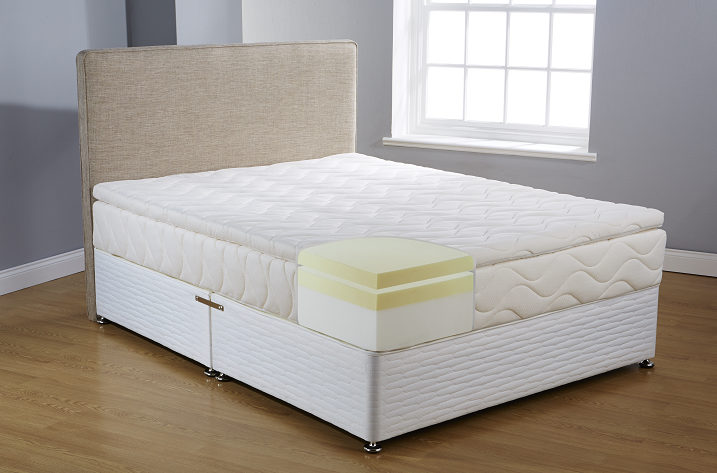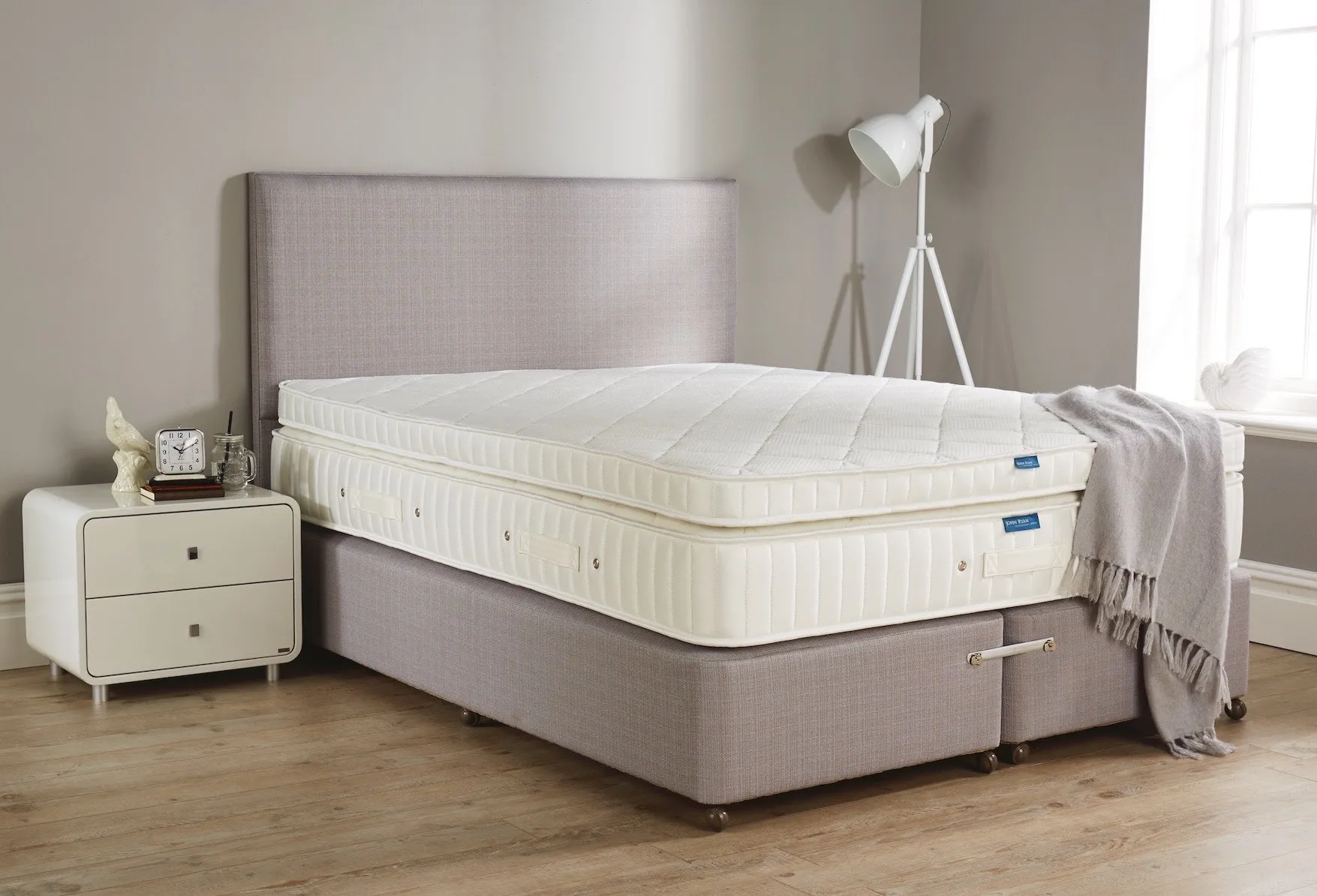Memory Foam & Hybrid Foam
June 2020What are the differences between Tempur and other memory foams?
Are you looking for a Tempur mattress but wondering what the difference is between Tempur and Memory foam? You’re not alone! This article will aim to simplify things for you. We’ll explain exactly what Tempurpedic foam is and whether or not it will be suitable for you or a memory foam alternative.

Tempur are the market leader who are charging in the region of £1500 – £3000 for a mattress alone, which makes one a really considered purchase. This is especially true when there are Memory foam mattress alternatives out there for a fraction of the cost! Then there’s a whole dizzying array of new Tempur mattress models with slightly different foams, covers and feels. It’s enough to make your head spin if you’ve just started looking for a new mattress!
Let’s delve a bit deeper to see if how Tempur and memory foam mattresses compare.
- Is Tempur the same as Memory Foam mattresses?
- What does a Tempur mattress feel like?
- Tempur mattress models explained
- How are Tempur mattresses made?
- Cheaper Tempur mattress alternatives
- Problems with Tempur mattresses
Tempur vs. Memory Foam – Are They the Same?
Tempur foam was the original memory foam of the 1990s. Tempur researched and developed the foam we now call “memory foam” as part of the NASA space missions for seat coverings (to allow astronauts to be comfortably held in space). Tempur fiercely defends their brand, given all the millions of research and development they spent on their mattress foam. Tempur will not refer to their foam as “memory foam” but as “Tempurpedic foam’. They have their own patented recipes for their ‘viscoelastic polyurethane’ mattress foam. So whilst all memory foam mattress technically are ‘Tempurpedic’ (i.e. they react to heat and pressure), only Tempur can use this term as it’s their brand.
Tempur foam isn’t available anywhere else other than at Tempur retailers, and is patented. However, the feel of Tempur is practically identical to cheaper Memory foam alternatives with viscoelastic foam, which is why they are so often compared.
What should a Tempurpedic Foam Mattress Feel Like?
So we know that Tempurpedic mattresses are a form of viscoelastic polyurethane foam. The Polyurethane Foam Association says, “viscoelastic foam is typified by its slow recovery after compression. When a weighted object (for example, the human body) is positioned on viscoelastic foam, the foam progressively conforms to the shape of the object, and after the weight is removed the foam slowly reassumes its initial shape. Due to this gradual recovery, viscoelastic foam also can be described as slow recovery foam”. The feel of Tempur mattresses has been described with the following descriptors by different owners:
- Soft slow sink
- Weightless sinking
- Spongey sink sensation
- Warm soft sand
- Weightless sleep
Comfort is subjective, but we believe the above descriptions are accurate for how Tempurs mattress range feels.
Tempur Mattress Models
They have three main models; the Tempur Original, which is the firmest (now called the Tempur Contour), the Tempur Cloud, which is the softest, and the Tempur Sensation, which is a version in-between the two that’s said to have more ‘bounce’. They have undertaken the original research and development and their prices bear this cost. Tempur also has a depth measure on their model names, such as 22 (which indicates a 22cm deep mattress).
The original Tempur models are using 85kg density ‘Tempur’ foam which has a firm feel. This is similar to firm latex mattresses. Then the other models are all starting to use slightly different densities.

Dreams and other authorised retailers sometimes microbrand the Tempur mattress with other suffixes or names. This can cause some confusion amongst customers as to which model is which. For example, the ‘deluxe’ tag is usually used on models over 21cm.
- TEMPUR Contour which replaced the TEMPUR Original (firm)
- TEMPUR Sensation (medium)
- TEMPUR Cloud (medium soft)
- TEMPUR Hybrid (medium firm)
To make matters even harder to analyse, few of the brands offer you the exact densities, qualities or depths of foams used, so it really is difficult to assess and compare mattresses. Some will offer a few of the facts, and the competitors some different select facts. Very few give you all the information; that’s where we differ.
How to compare Tempur Mattresses
To compare Tempur and memory foam mattresses you need to know the following details of each mattress you’re looking at.
- How many layers and components does the mattress have?
- What are the depths of each of the mattress layers?
- What are the densities and associated firmness ratings for the foams?
There is also the base layer or Reflex Foam to consider which, confusingly, will have a different density rating: typically 30-33kg density. Conversely, this is firmer than Memory Foam because it has a different chemical composition! Confused? Bare with us!
Memory Foam typically has a density from 40kg (soft) to 85kg (firm) and there is a tolerance in the manufacturing techniques, so an 85kg foam could be anywhere between 80kg and 90kg in reality. Reflex Foam is a much denser foam, so its firmness is usually measured between 30-33kg, as an 85kg piece of reflex would feel like a slab of marble!
Once you have this detail it means you can start to assess the quality and overall feel of the mattress.
To be able to compare you need to know the exact depth and density of the foam
These are details that the likes of Tempur, Eve and Casper don’t disclose for some reason


How Are Tempurpedic Mattresses Made?
Tempur mattresses are made using the standard foam construction method of ‘layering up’ foams. These layers usually start with a firmer base, such as reflex or support foam, and then get progressively softer as the layers get close to the top of the mattress. The layers are usually stuck together with an adhesive glue which is sprayed on, which differs from a natural fibre mattress (where wool tufts are used, not glue). You can see below what a layered mattress looks like. The white reflex foam sits at the bottom, and then there are layers of memory foam from firmer to soft.
Unfortunately, this method means that all the Tempur mattresses are one-sided and cannot be turned over. We have discussed why this is a real drawback in our details article here. In summary, it means your mattress is of higher risk of mattress settlement as you can’t turn it over to even out the initial wear.

Cheaper memory Foam alternatives to Tempur
We get asked all the time what the best cheaper alternative to a Tempur mattress is. Our advice is always the same: to aim to get the best quality mattress for your budget. Once you’re looking at spending over £750 on a mattress, we advise you should start looking away from Memory foam as there are far better natural fibre sprung alternatives that remove the drawbacks of memory foam.
However, if you’re on a really tight budget then entry-level Memory foam mattresses may be a suitable alternative to Tempur models. The cheaper end of the market typically sells £200 mattresses, maybe using much softer 40kg density foam, at maybe 2cm depth, with a lower hardness rating which is far softer. They can offer products at this price because they are probably offering low quality cheaper Memory Foams, some of which may be imported from outside the UK. You then have everything in between. Obviously, if you’re buying a cheap mattress it’s not going to last more than a couple of years or have the quality support/comfort you potentially need. Though we do appreciate that everyone is at a different price point.

- What to expect from a £500 Mattress
- What to expect from a £750 Mattress
- What to expect from a £1000 Mattress
- What to expect from a £1250 Mattress
- What to expect from a £1500 Mattress
- What to expect from a £2000 plus Mattress
Why do Tempur mattresses get so hot?
If you google Tempur mattress reviews you quickly find that people either love them or hate them. Most of the complaints are heat retention. This is true of all viscoelastic foams. They will all retain heat. It’s part of what helps them soften pressure and heat as the foam warms up. So if you’re a warm sleeper then you probably want to avoid Tempurpedic and Memory foams all together. We recommend looking at a Natural Fibre mattress instead which are far cooler and breathable than synthetic foams.
It also leads to the second issue of people feeling ‘stuck’ in bed at night. As they sink into the foam, which holds them when they come to move, some people struggle. As the foam is slow to react it can make turning during the night really difficult and frustrating for many.

Mattress Buying Guide
We know all of this Tempur mattress information can be overwhelming. However, it really is in your best interests to understand potential mattress purchases before spending your hard-earned cash on a new bed.
Do you need more help to work out whether a Tempur mattress or memory foam model is the best one for you? We have our handy beginner guide on all you need to know before buying a mattress. Ryan explains in detail just what you need to look out for to get the very best mattress for your budget.
Summary
Tempur is a really successful brand of Tempurpedic mattress. However, you’re also paying for their worldwide marketing budgets and retailer concessions. Every mattress brand tries to have its own unique selling point using a barrage of luxury, sumptuous and qualitative descriptions, but bear in mind that you want to know hard cold facts that you can compare.
The only sensible way to compare Memory Foams is via datasheets for each of the foams. The difficulty is manufacturers won’t usually release them. If you’re struggling to find out more information about certain memory foam or Tempurpedic mattress then why not get in touch below with our small friendly team of experts? We can help guide you to find the most suitable mattress.

Dreaming of the perfect nights sleep?

Ask us a question
There are over 6000 questions and answers submitted by you on all questions about mattresses and bed problems. Enter a keyword such as Vi Spring, John Lewis beds, bad back or Memory Foam and see if your question has already been answered.
If you can’t find an answer in knowledge hub, ask a new question. We aim to respond to all questions within one working day.
Newsletter
Enter your email to join our newsletter. We’ll send you occasional news and mattress expertise.
